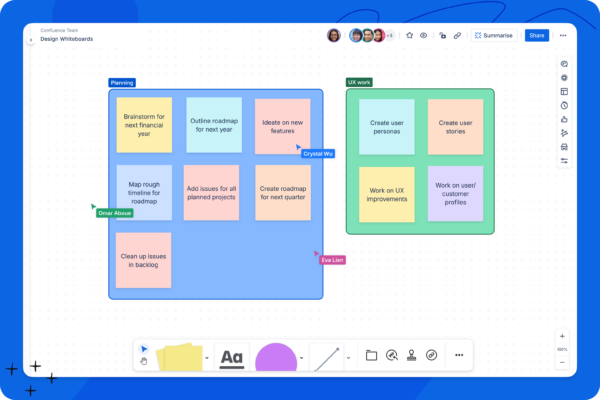Orchestrating success: How Atlassian’s marketing team plays in sync
Explore effective strategies used by Atlassian to enhance collaboration across marketing teams through a unified platform.
The learnings in this blog post are based on the session, “Orchestrating success: How Atlassian’s marketing team plays in sync”, presented at Atlassian’s Team ’25 conference. You can check out this session and others on demand.
Imagine if an orchestra were to play a piece of music using the same sheet but without a conductor to manage the tempo. Even if each instrument was only a tiny bit out of time from the next, the song would result in a cacophony of noise instead of a coherent musical piece.
This is exactly how it feels for marketing teams that are working out of sync with each other and their cross-functional stakeholders. And as your organization grows, the more likely teams may be working just a little off tempo: deadlines get missed, and priorities clash with too many simultaneous versions of one plan.
Teams are drowning in disconnected tools, processes, and systems that were never designed to work together. According to research conducted by The Enterprise Strategy Group, 86% of enterprise organizations use more than 6+ project management tools. The same study found that 42% of organizations use more than 11 project management tools across their businesses.
Tool sprawl weighs teams down and often leads to duplicative work, sinking morale, and inhibiting the creative spark needed for competitive marketing teams. On the other hand, marketing teams that use a centralized platform with brainstorming features, robust task management and goal-setting capabilities, and seamless cross-functional partnerships can get campaigns done faster.
A single, consolidated environment can be powerful in supporting teams through every step, from ideation and planning milestones to tracking and documenting progress, so everyone stays on the same page and projects move forward smoothly.
At Atlassian, teams still work in their own specialized ways, but they just do it on a centralized platform to make knowledge discoverability, project visibility, communication, and cross-functional collaboration seamless.
So, let’s explore 5 ways Atlassian’s marketing teams use their own platform internally to streamline work with the right tools and processes to make the most out of working together.
#1. Brainstorm first, refine later
Pro tip: Use Confluence whiteboards as your digital scratchpad to get the most out of your brainstorming session. The AI capabilities in Confluence whiteboards can help you organize your ideas and break them into actionable steps.
Don’t overthink the ideation phase. That’s where Confluence whiteboards comes into play. Prior to this feature, teams might use a Google Doc, sticky notes, or have to host an in-person meeting to physically whiteboard out their project.
With Confluence whiteboards, teams can harness the flexibility of real-time brainstorming offered by whiteboards or sticky notes while also having access to AI grouping tools to help keep creative ideas organized.

Once their ideas are organized, Atlassian’s marketing teams will use the AI work breakdown feature in whiteboards to convert all of the creative ideas into actionable Jira steps.
Comparatively, teams that don’t work on a centralized platform like Atlassian Cloud will have to spend additional time and effort manually exporting and importing these ideas from tool to tool at the risk of losing context. With the AI work breakdown feature, teams can quickly turn their ideas into digestible items that will pave the way to their goals.
#2. Create a central page as your single source of truth
Pro tip: Create a “Home Page” as your single source of truth. Embed all related work and key links to keep everyone in sync.
After creating work items in Jira post-brainstorming session, Atlassian’s marketing teams establish a single source of truth by embedding those work items into a main Confluence page, whether that’s for a piece of work, a project, or a strategy.
This allows everyone to know what the team is working on, the statuses, due dates, and who’s assigned to what. Bring the task management capabilities of Jira and project planning power of Confluence into a single page, all without having to toggle between either app.
#3. Continuously align work with team, department, and organization-wide goals
Pro tip: Keep your work visible and stay in sync by aligning it to your strategic team, department, and organization-wide goals. This will ensure that your teams prioritize and work on the right things.
If a work item is not moving one of your goals, consider whether it is really worth doing.
Atlassian’s marketing team uses the objective key results (OKR) framework for goal setting within the Atlassian Goals app. By hosting their OKRs in the Goals app, Atlassian teams have clear visibility on what adjacent teams and other stakeholders are working on since every team’s goal resides on a centralized platform.
As requests come in from other teams, Atlassian’s marketing teams can set up work in Jira that ladder directly into Goals. Time spent prioritizing work is expedited because the Goals feature makes it easy to compare tasks to be done to the broader organizational goals.
#4. Share knowledge across teams
Pro tip: Knowledge sharing is an ongoing cycle. Maintain your single source of truth page in Confluence, track work and progress across teams in the Jira Plans view, and share Loom videos to streamline communication, asynchronously.
Clear visibility across teams and clear channels for knowledge sharing are crucial for modern marketing. Atlassian’s marketing teams can easily see work happening across product teams without having to switch tools through features such as Jira Plans, shared calendars, Smart Links, and Loom.
Jira Plans
With Jira Plans, Atlassian’s marketing teams can easily see what’s on product roadmap the horizon, decreasing the need for disruptive, repeat exchanges with product managers.
Shared calendars
The greater Atlassian marketing team also uses a high-level marketing calendar as a one-stop to refer to for all upcoming tasks, campaigns, and events. This calendar minimizes meetings by offering an easy-to-grasp, high-level calendar view of projects and goals with real-time updates.
Smart Links
Another way Atlassian’s marketers save valuable time is by reducing context-switching through Smart Links. Smart Links offer a window into work from other products, including Atlassian and third-party solutions, providing the ability to edit in real time without having to switch between tools.
For example, Atlassian’s marketers can view a Confluence page corresponding to a Jira work item without switching tools. They can also view an embedded video on a Confluence page without navigating to another site.

Smart Link to a Loom
Smart Links can even embed Loom videos to offer a deeper explanation of the work item. By offering asynchronous explanations of niche work items, Atlassian’s marketing teams can quickly get up to speed without having to wait for a live conversation. This also enables our global teams to operate efficiently.
Atlassian’s marketing teams also use Loom videos in weekly status updates hosted in Atlassian Projects. This allows teams to stay up to date without being inundated with heavy reading or time-consuming meetings. Atlassian employees saved 5,000 hours of focus time in just two weeks by replacing meetings with Loom videos.
Empowering teams with the flexibility to shape their own processes is key to unlocking creativity and innovation, especially in dynamic fields like marketing. Rather than imposing rigid structures too soon, give your teams the freedom to experiment and discover what works best for them.
Supercharge modern marketing with the Atlassian Teamwork Collection
The Atlassian Teamwork Collection enhances marketing teams by providing a suite of interconnected tools that streamline collaboration, improve communication, and boost productivity by connecting all work to business impact. Through a unified set of tools and AI-driven insights, the Teamwork Collection is designed to scale with the needs of marketing teams.
If you’re inspired by the frameworks of Atlassian’s marketing teams and would like to apply them to your own organization, chat with a specialist who can get your teams up to speed.

